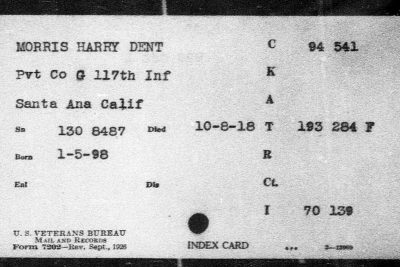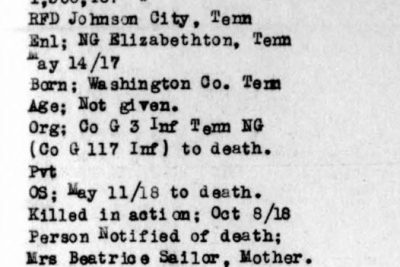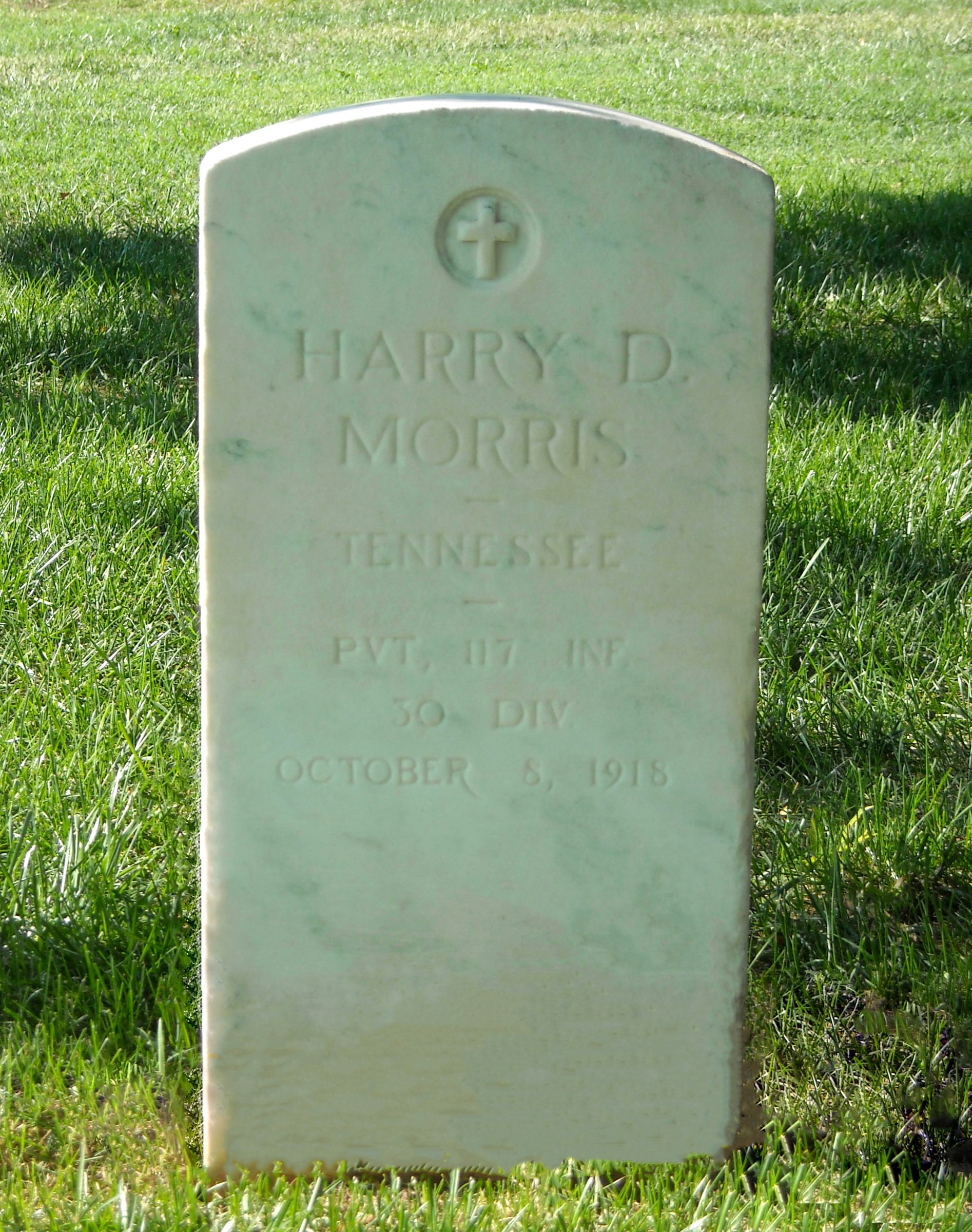Private Harry Dent Morris, Service Number 1308487
Harry was born on 5 January 1898 at his parent’s home in Johnson City, Washington County, Tennessee. He enlisted in the Tennessee Army National Guard in Elizabethton, Tennessee on 14 May 1917. Harry was assigned to the 3rd Infantry Regiment’s Company G that was based there in Elizabethton. His time in the Guard was short lived when they were activated and called into Federal Service by the President on 25 July 1917.
Now, Company G as were all the other companies in the 3rd were now preparing for active duty and getting ready for their deployment order. That order soon came and they were to deploy to Camp Sevier, Greenville, South Carolina to form the new 30th Division. The 3rd arrived Camp Sevier on 8 September 1917. There they would join units from North and South Carolina, as well as those from Tennessee to form the core of the 30th Division, later known as the Old Hickory Division in honor of General and President Andrew Jackson. General Order No. 4 dated 12 September 1917, Headquarters 30th Division brought about a big change for Harry and the 3rd. They were reorganized into the 117th Infantry Regiment under the 59th Infantry Brigade and Harry stayed with Company G, 2nd Battalion.
Harry departed Camp Sevier on 5 May 1918 with Company G for Camp Mills, Long Island, New York to await transportation overseas. He along with others were given leave and for days afterwards and on the ship nursed sore necks from the hours they spent looking at all the tall skyscrapers of New York City. After boarding the SS Northumberland in Brooklyn, New York, they set off for Liverpool, England on 11 May and arrived on 23 May. After disembarking the ship he and the four infantry regiments of the 30th Division boarded troop trains and were taken to the port cities of Dover and Folkestone for the channel crossing over the next couple of days. He and his company arrived the port city of Calais, France on the 25th. As the 30th Division piecemealed into France just as they had done into England, they were taken to Audruicq by train and marched the short distance to the various towns and villages known as the Eperlecques Training Area in France. Harry was billeted with the 117th at Nortbecourt and began Phase “A” Training with the British 39th Division on 10 June 1918.
Phase “A” was to be completed on 10 July, but was extended to the morning of 16 July. Phase “B” began the same day for the 30th Division with a three day march into Belgium. Upon arriving the Poperinghe Area, the 117th was billeted in one of the numerous camps and were intergraded over the next month into actual battlefield operations and trench warfare conditions with active combat units. Phase “B” was completed on 10 August and Phase “C” the last training phase was cancelled and the 30th were declared combat ready. Operational orders came down on the 14th and the 30th Division was to relieve the British 33rd Division starting the night of 16 August in the Canal Sector near Ypres, Belgium. The Ypres-Lys Offensive began on 19 August 1918 and the 30th would now be in the thick of the fighting to the very end of the war.
Harry and the 30th were given a breathing spell after being relieved from the Ypres-Lys Offensive on 5 September and were entrained to the St. Pol area and companies F, G & H of the 117th were billeted at Beauvois, France to resupply, do some more training and get a little rest from all the heavy artillery explosions. On the 17th the 30th Division made the move to the Puchevillers Area where they would come under the control of the 4th British Army as would the American 27th “New York” Division to join in the Somme Offensive, also known as the One Hundred Day Offensive.
Harry was killed in action on 8 October 1918, the first assault day of the Battle of Montbrehain while engaging German Forces at Premont. He participated in two Unit Campaigns: Ypres-Lys Offensive in Belgium and the Somme Offensive in France. Harry also fought in the Battle of Bellicourt on the Hindenburg Line. He was first interred at the British Military Cemetery at Fricourt, France and later moved to the Somme American Cemetery in Bony, France. After the war his oldest sister (Beatrice Morris Saylor) decided that Harry should come home and she requested he be returned to Johnson City. He was interred at the Mountain Home National Cemetery, Section B, Row 13, Site 8 on 8 April 1921.
Harry’s the son of James A. Morris and Florence “Florie/Flo” Boring. Both preceded him in death, his father in April 1914 and his mother a year later in April 1915.
— Submitted by Allen D. Jackson, USAF (Ret) Historian, Johnson City/Washington County TN Veterans Memorial Foundation
- Rank: Private
- Date of birth: 5 January 1898
- Date of death: 8 October 1918
- County: Washington
- Hometown: Johnson City
- Service Branch: Army
- Division/Assignment: Company G, 117th Infantry Regiment, 30th Infantry Division
- Theater: Europe
- Conflict: World War I
- Burial/Memorial Location: Mountain Home National Cemetery, Johnson City, Washington County, TN
- Location In Memorial: Pillar V, Bottom Panel
- Contact us to sponsor Harry D. Morris
Image Gallery
Click a thumbnail below to view at full size.




